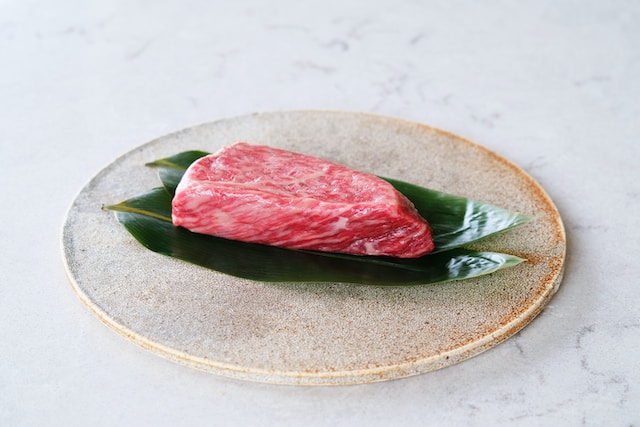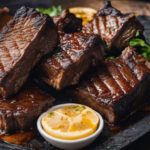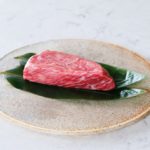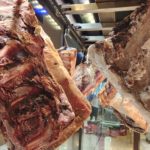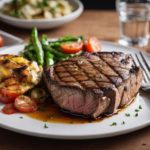Ever stared at a menu and wondered what’s so special about Wagyu beef? We’ve been there too, fascinated by how this Japanese beef breed has claimed its high-end status worldwide. Our comprehensive deep-dive into the history and tradition of Wagyu beef answers all your ‘steak questions’.
Welcome to the flavorful journey that is Wagyu; we promise it will be an appetizing ride!
Key Takeaways
- Wagyu beef originated over 35,000 years ago from native Asian cattle and has been a part of Japanese cattle raising traditions for over 2,000 years.
- The introduction of Western food to Japan in the late 19th century had a significant impact on the culinary scene and led to the fusion of Eastern and Western flavors in dishes containing Wagyu beef.
- Wagyu beef offers numerous health benefits due to its higher levels of monounsaturated fats, omega-3 fatty acids, lower levels of unhealthy saturated fats, and high content of conjugated linoleic acid (CLA).
- The care given to Wagyu cattle in Japan is seen as an art form, with farmers providing special diets and massages to enhance flavor and tenderness. There is also a grading system in place to evaluate each cut of meat based on marbling, color, texture, firmness, and fat quality.
The Origins of Wagyu Beef
Wagyu beef traces its genetic strain back over 35,000 years and has been a part of Japanese cattle raising traditions for more than 2,000 years.
Tracing the genetic strain back over 35,000 years
Scientists have uncovered the mystery of Wagyu beef’s unique traits by following its genetic pathway back into history. These ancient roots span over 35,000 years, painting a picture of long-preserved traditions and careful breeding practices.
Its journey begins with the native Asian cattle, predecessors who passed on their coveted characteristics to future generations. Over millennia, this lineage evolved under regional influences, weather patterns and local diets creating what we know today as the esteemed Wagyu breed.
This research has not only given us fascinating insights into how special Wagyu truly is but also emphasized why it continues to be recognized worldwide for superior quality in flavor and tenderness.
Cattle raising in Japan for labor for 2,000 years
For over 2,000 years, cattle in Japan were primarily raised for labor rather than for their meat. These diligent animals played a vital role in the agricultural and industrial sectors, helping with tasks like farming and transportation.
The Japanese people developed techniques to selectively breed cattle that possessed the strength and endurance required for these demanding jobs. This long-standing tradition of cattle raising demonstrates the deep connection between humans and animals in Japanese culture.
Introduction of Wagyu cattle from Northern China in 200 AD
The Wagyu breed of cattle, known for its exceptional beef, has a rich history that dates back thousands of years. One important milestone in the origins of Wagyu beef is its introduction to Japan from Northern China in 200 AD.
These cattle were brought to Japan for their labor and eventually became an integral part of Japanese farming traditions. The arrival of these cattle marked the beginning of a long journey that would lead to the development and popularity of Wagyu beef as we know it today.
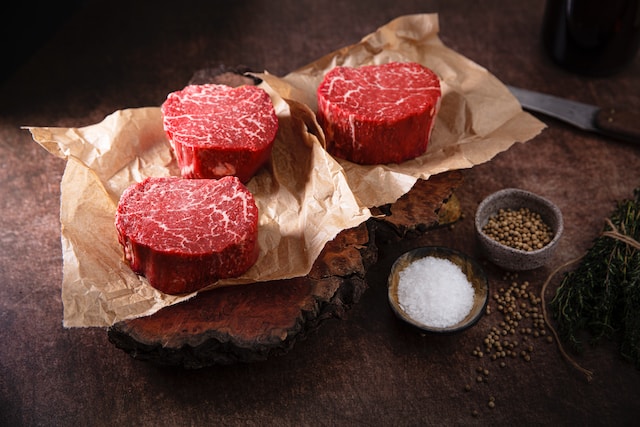
The Journey of Wagyu Beef to the Modern Age
Wagyu beef made its way to the modern age through the introduction of Western food to Japan and the subsequent development of Wagyu cattle in modern times.
Introduction of Western food to Japan
When Western food was introduced to Japan, it had a significant impact on the culinary scene. Traditional Japanese cuisine focused heavily on rice, seafood, and vegetables. However, with the arrival of Western influence in the late 19th century, new foods like beef became more accessible to the Japanese people.
This introduction of Western food brought about a shift in taste preferences and cooking techniques. As a result, Japanese chefs started incorporating ingredients like butter, cheese, and bread into their dishes.
The fusion of Eastern and Western flavors gave rise to unique creations that are now enjoyed by meat lovers all over the world.
Development of Wagyu cattle in modern times
In modern times, the development of Wagyu cattle has been a fascinating journey. These unique and prized cows have come a long way since their origins in Japan. Over time, there has been cross-breeding with imported stock, mostly from Europe.
As a result, Wagyu beef now boasts incredible tenderness, marbling, and flavor that meat lovers around the world appreciate. Today, Wagyu beef holds a special place in the culinary world and continues to gain popularity for its exceptional quality and taste.
Popularity of Wagyu beef today
Wagyu beef has gained immense popularity in recent years. Its reputation for incredibly tender meat with a high level of marbling has made it highly sought after by meat lovers around the world.
The unique flavor and melt-in-your-mouth texture of Wagyu beef have contributed to its rise in popularity, making it a favorite among food enthusiasts and top chefs alike. Despite being relatively expensive compared to other types of beef, the demand for Wagyu continues to grow due to its exceptional quality and unparalleled taste experience.
The Difference Between Purebred and Full-Blood Wagyu
Purebred and full-blood Wagyu are two terms often used in reference to the breed of cattle that produce Wagyu beef. While they may sound similar, there is a slight difference between the two.
Purebred Wagyu refers to cattle that have been bred from registered purebred Wagyu parents, but with some crossbreeding involved. On the other hand, full-blood Wagyu refers to cattle that have no crossbreeding at all and can be traced back directly to the original Japanese bloodlines.
In terms of their characteristics and flavor profile, both purebred and full-blood Wagyu exhibit exceptional marbling, tenderness, and rich flavor due to their genetic makeup. However, because full-blood Wagyu has a more direct lineage to the original Japanese bloodlines, it is often considered more authentic and highly valued in the market.
It’s important to note that both types of Wagyu beef offer an incredible dining experience with their unique qualities. Whether you choose purebred or full-blood Wagyu, you’re sure to indulge in a steak like no other – melt-in-your-mouth tender and bursting with exquisite flavors.
Health Benefits of Wagyu Beef
Wagyu beef offers numerous health benefits due to its higher levels of monounsaturated fats and omega-3 fatty acids, as well as lower levels of unhealthy saturated fats. It is also rich in conjugated linoleic acid (CLA), making it a healthier choice for meat lovers.
Higher levels of monounsaturated fats and omega-3 fatty acids
Wagyu beef is not only known for its incredible taste and tenderness but also for its health benefits. One of the reasons why it stands out from other types of beef is because it contains higher levels of monounsaturated fats and omega-3 fatty acids.
These are the “good” fats that can have a positive impact on our health. Monounsaturated fats are known to help lower bad cholesterol levels, reducing the risk of heart disease. Omega-3 fatty acids, on the other hand, are essential for brain health and can contribute to a healthier heart as well.
So when you choose Wagyu beef, you’re not just indulging in a delicious meal – you’re also making a choice that supports your overall well-being.
Lower levels of unhealthy saturated fats
Wagyu beef stands out not only for its tenderness and flavor but also for its health benefits. Unlike other types of beef, Wagyu contains lower levels of unhealthy saturated fats. This means that when you indulge in a juicy Wagyu steak, you can savor the rich taste without worrying about consuming excessive amounts of harmful fats.
By choosing Wagyu, you’re treating yourself to a delicious meal while making a healthier choice for your body.
Rich in conjugated linoleic acid (CLA)
Wagyu beef is not only known for its tenderness and marbling, but it also has health benefits that make it even more appealing to meat lovers. One of these benefits is the high content of conjugated linoleic acid (CLA).
CLA is a type of fatty acid that has been linked to various health benefits, such as reducing body fat, improving immune function, and decreasing inflammation. So when you enjoy a juicy Wagyu steak, you’re not just satisfying your taste buds – you’re also nourishing your body with this beneficial compound.
The Tradition and Appreciation of Wagyu Beef
We delve into the revered care of Wagyu cattle in Japan, the grading system for this prized beef, and its cultural significance within Japanese cuisine.
Revered care of cattle in Japan
In Japan, the care of cattle is seen as nothing short of a revered art form. Farmers go to great lengths to ensure the well-being and happiness of their cows. These animals are treated with utmost respect and given special diets and massages to enhance their flavor and tenderness.
The traditional practice of raising Wagyu cattle involves providing them with comfortable living conditions, including ample space to roam and access to clean water. This level of care contributes significantly to the premium quality and taste that Wagyu beef is known for around the world.
The deep cultural appreciation for Wagyu extends beyond just keeping the cows happy. In Japan, there is even a grading system in place to evaluate the marbling, color, texture, firmness, and fat quality of each cut of meat.
Based on these criteria, each piece receives a specific grade – from A1 (the lowest) all the way up to A5+ (the highest). This meticulous attention ensures that only the very best cuts make it onto our plates.
In Japanese cuisine, Wagyu holds immense significance as a delicacy enjoyed on special occasions or served in high-end restaurants. The rich marbling and melt-in-your-mouth tenderness are what sets this beef apart from others around the world.
Grading of Wagyu beef in Japan
In Japan, Wagyu beef is graded based on its quality and marbling. This grading system helps to ensure that consumers are getting the best possible meat. The highest grade is A5, which indicates the highest level of marbling and tenderness.
Lower grades such as B3 or C1 indicate less marbling and a lower level of quality. The grading process involves trained inspectors who carefully evaluate each cut of beef based on factors like color, texture, fat distribution, and overall appearance.
This meticulous grading system ensures that only the finest cuts of Wagyu beef make it to market, giving meat lovers a guarantee of exceptional taste and tenderness every time they indulge in this prized delicacy.
Cultural significance of Wagyu beef in Japanese cuisine
Wagyu beef holds a deep cultural significance in Japanese cuisine. Its rich history and tradition are deeply intertwined with the country’s food culture. The exceptional quality and unique taste of Wagyu beef have made it a prized ingredient in traditional Japanese dishes, such as sukiyaki and shabu-shabu.
In Japan, there is a profound appreciation for the care that goes into raising Wagyu cattle, resulting in its high-grade status and reputation worldwide. The marbling of fat within the meat gives it an unmatched tenderness and flavor profile that sets it apart from other types of beef.
Today, Wagyu beef continues to be revered and cherished by both locals and international food enthusiasts alike for its remarkable culinary contributions to Japanese cuisine.
The history and tradition behind Wagyu beef is fascinating. Did you know that the genetic strain of Wagyu cattle can be traced back over 35,000 years? That’s a long time! In Japan, cattle were raised for labor purposes for about 2,000 years before the development of the Wagyu breed.
The origins of Wagyu cattle can actually be traced back to Northern China around 200 AD. Today, Wagyu beef is known for its tenderness, marbling, and incredible flavor. It’s no wonder that it has become so popular and highly valued in the meat market.
But how did Wagyu beef make its way to our modern age? Well, it all started with cross-breeding native Japanese cattle with imported stock from Europe. This helped improve the quality and characteristics of the breed over time.
Now we have different types of Wagyu beef like Kobe beef and other well-known varieties. The tradition and appreciation for this exquisite meat are deeply rooted in Japanese culture as well.
Cattle are revered and cared for meticulously in Japan, resulting in some of the best-quality beef we have today.
So next time you sink your teeth into a juicy piece of Wagyu steak, take a moment to appreciate its rich history and all the care that goes into producing such an exceptional piece of meat.
Conclusion
In conclusion, the history and tradition behind Wagyu beef are rich and fascinating. From its origins in Japan over 35,000 years ago to its journey into the modern age, Wagyu has become synonymous with exceptional quality and taste.
The reverence for cattle raising in Japan and the meticulous care given to each animal contribute to the unique flavor profile that makes Wagyu beef so highly regarded today. Whether enjoyed as a gourmet delicacy or savored in traditional Japanese cuisine, Wagyu beef continues to be a symbol of excellence in the world of meat.
FAQs
1. Where did Wagyu beef originate?
Wagyu beef originated in Japan, specifically from the native Japanese cattle breeds.
2. What makes Wagyu beef different from other types of beef?
Wagyu beef is known for its high level of marbling, which refers to the intramuscular fat that gives it a buttery texture and rich flavor. It also has a higher percentage of unsaturated fats compared to other types of beef.
3. How is Wagyu beef traditionally raised and cared for?
Traditionally, Wagyu cattle are raised in specific regions of Japan where they have access to clean water, healthy feed such as rice straw and grains, and are given regular massages or brushed with sake for relaxation. They are also allowed to roam freely and live stress-free lives.
4. Is all Wagyu beef considered Kobe beef?
No, not all Wagyu beef can be considered Kobe beef. Kobe is a specific type of Wagyu that comes from the Tajima strain of Japanese Black Cattle raised in the Hyogo Prefecture according to strict guidelines set by the Kobe Beef Marketing & Distribution Promotion Association.
Greetings!
With over two decades of diverse experience in the meat industry, I proudly stand as an expert in all things meat. My journey commenced with a strong foundation in hospitality, where I honed my culinary skills as a chef in prestigious restaurants and on luxurious superyachts worldwide.
However, my true passion lies in the art of butchery. Throughout my extensive career, I have had the privilege of working with renowned meat purveyors and mastering the craft of meat cutting and preparation. From breaking down whole carcasses to meticulously selecting prime cuts, my butchery expertise is at the core of my meat knowledge.
Having immersed myself in various cultures and cuisines, I have honed my skills to deliver exceptional dining experiences, crafting delectable dishes that celebrate the natural flavors of different meats. Whether it’s sourcing the finest meats for discerning clients or sharing valuable tips on meat selection and cooking, I take pride in elevating the meat experience for both professionals and enthusiasts.
My journey has taken me from the bustling kitchens of top-rated restaurants to the heart of meat processing facilities, gaining insights and honing my skills to become a true meat connoisseur. Now, I am enthusiastic about sharing my expertise, offering valuable insights on meat selection, cooking techniques, and the art of butchery.

